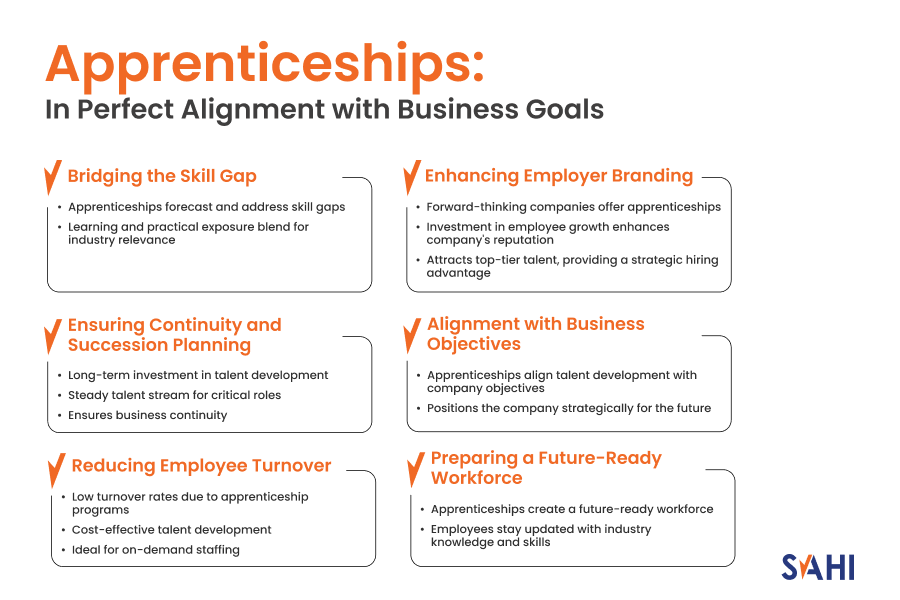In the ever-evolving world of business, the way companies attract and nurture talent has undergone a significant transformation. Traditional hiring methods have long been the cornerstone for businesses in search of new talent.
However, the modern business landscape beckons for innovative solutions that align with the rapidly changing demands of industries. Enter apprenticeships, particularly those under the National Apprenticeship Promotion Scheme (NAPS), which have emerged as a pivotal tool in redefining the realm of talent acquisition and workforce planning.
Traditional Hiring: The Tried and True
Traditional hiring methods, encompassing job boards, recruitment agencies, and internal HR processes, have been relied upon for decades. These methods, while effective, often come with a host of challenges.
For one, it can be a lengthy process, often leading to a significant time-lapse between recognizing the need for a role and actually filling it. Additionally, there’s the age-old conundrum of experience.
Many candidates may have the theoretical knowledge but lack the practical experience, resulting in a longer onboarding process. In an era where businesses operate at breakneck speeds, these methods, although trusted, might no longer be the most efficient or cost-effective.
The Rise of Apprenticeships: A Modern Approach
Apprenticeships, especially those driven by schemes like the NAPS, have emerged as a powerful counterpoint to the conventional recruitment process. These programs are not merely about hiring; they’re about strategically grooming talent to serve the specific needs of a business.
This approach provides companies with a dual advantage. They play a role in shaping the apprentice’s skills and knowledge from early on, ensuring alignment with the company’s objectives. Plus, businesses simultaneously benefit from a cost-effective talent development solution.
The modern business landscape is characterised by rapid technological advancements, shifting market dynamics, and an increasing emphasis on specialised skills. In such an environment, apprenticeships offer a solution that not only addresses the immediate talent needs but also looks to the future.
They provide businesses with a mechanism to forecast their talent requirements and strategically prepare for them.
Apprenticeships, especially those under the National Apprenticeship Promotion Scheme, are no longer just an alternative to traditional hiring methods. They represent the future of workforce planning and strategy, carving a pathway for businesses to achieve growth and maintain a strategic advantage in the market.
The Existing Hiring Methods: A Glimpse Into Conventional Wisdom
The domain of talent acquisition has been a dynamic one, seeing shifts in methodology as businesses evolve and the needs of industries change. Predominantly, the following methods have held fort in the recruitment ecosystem:
Recruitment Agencies
These entities serve as intermediaries, connecting potential candidates with companies. They often maintain a vast database of candidates and can quickly respond to hiring requirements.
Internal HR Processes
In-house recruitment teams that post vacancies, screen applications, and conduct interviews. They have a more intrinsic understanding of the company’s culture and needs.
Employee Referrals
Capitalising on the networks of existing employees to find potential candidates. It’s often deemed more reliable since the referring employee has a stake in the recommendation.
Campus Recruitment
Directly sourcing fresh talent from educational institutions, ensuring a continuous inflow of new, young talent with up-to-date educational backgrounds.
The Limitations: Where Conventional Methods Fall Short
Despite their widespread usage, these methods come with inherent challenges:
- Time-Consuming
From posting job vacancies to interviewing candidates, traditional hiring can be a long-winded process.
- Cost Implications
Using intermediaries like recruitment agencies can be expensive, given their commission-based structures.
- Mismatch of Skills
There’s often a gap between what’s taught in educational institutions and what the industry demands. Thus, it leads to the classic conundrum of ‘qualified but not skilled.’
- Lack of Specialisation
Job boards, catering to a vast audience, might not always have the specialised talent a particular industry or role demands.
- Cultural Misalignment
Without firsthand experience or engagement, there’s always the risk of hiring someone who might be a skill fit but not a cultural fit.
Challenges in Strategic Workforce Planning
In the broader context of strategic workforce planning, the emphasis is not just on hiring but also ensuring that the talent aligns with long-term business goals. But traditional hiring methods pose further challenges:
- Short-term Vision
Traditional methods often focus on immediate hiring needs rather than long-term workforce strategy, leading to reactive rather than proactive hiring.
- Lack of Adaptability
With the rapid evolution in job roles, especially in sectors like technology, traditional methods might not be agile enough to adapt.
- Skill Development Post-Hire
Once hired, significant resources might be spent on training individuals, aligning them with the specific needs of the business.
- Inefficient Utilisation of Talent
Without a strategic vision, businesses might end up underutilizing talent or placing them in roles that don’t fully leverage their potential.
The pivot towards apprenticeship programs, particularly those under the National Apprenticeship Promotion Scheme, emerges as a compelling solution against this backdrop.
Offering a blend of practical experience with structured learning, apprenticeships present an opportunity to bridge the gaps inherent in traditional hiring methods.
It allows for aligning talent acquisition more closely with workforce strategy and business growth objectives.
The Strategic Value of Apprenticeships: Crafting a Competitive Edge in Talent Acquisition
The recruitment paradigm is undergoing a shift. As companies grapple with the complexities of the modern hiring landscape, there’s an increasing recognition of the multifaceted advantages apprenticeships bring to the table.
It’s particularly true when viewed through the prism of the National Apprenticeship Promotion Scheme (NAPS). Apprenticeships aren’t merely a hiring route; they’re a strategic tool enabling businesses to chart a course for sustained growth and innovation.
The Multi-faceted Benefits of Apprenticeships
Holistic Development
Unlike traditional hiring, where you often get a candidate with theoretical knowledge, apprenticeships provide a hands-on approach. Apprentices are exposed to real-world scenarios, cultivating both technical and soft skills.
This ensures that by the end of their tenure, they are not just job-ready but also aligned with the specific nuances and requirements of the industry.
Immediate Productivity
A significant advantage of hiring apprentices is their state of readiness. Given their blend of formal education and on-the-job training, apprentices are often primed for immediate deployment.
Therefore, it reduces the lag between hiring and actual job commencement.
Cost-Effective Hiring Solution
Apprenticeships, especially under the NAPS, can lead to considerable cost savings. The structure of these programs often means reduced recruitment and training costs. You can choose from modern staffing solutions, such as contract, temporary, or permanent options.
On that note, it’s important to mention SAHI – a digital platform that fulfils all these requirements. If old hiring solutions are draining your business, SAHI offers modern solutions that are tailored to your business needs. You can hire for a few weeks, month, or even longer easily.
Flexibility and Adaptability
Apprenticeship programs are inherently flexible. They can be tailored to address specific industry needs, ensuring that the skills being developed are both current and relevant.
This adaptability ensures businesses remain agile in the face of changing industry dynamics.

Apprenticeships: In Perfect Alignment with Business Goals
Bridging the Skill Gap
One of the primary challenges in workforce planning is forecasting and addressing skill gaps. Apprenticeships, with their blend of learning and practical exposure, ensure a pipeline of talent that is attuned to the industry’s current and future requirements.
Enhancing Employer Branding
Companies that offer apprenticeship programs are often viewed as forward-thinking and invested in the growth of their employees. This not only enhances the company’s reputation in the market but also makes it an attractive proposition for top-tier talent, giving businesses a strategic advantage in the hiring market.
Ensuring Continuity and Succession Planning
Apprenticeships are a long-term play. By investing in apprentices, companies can ensure a steady stream of talent, ready to step up as and when required. This is particularly valuable for critical roles, ensuring business continuity.
Alignment with Business Objectives
The structure of apprenticeship programs allows businesses to mould talent in line with their objectives. This means companies aren’t just hiring for the present but are also strategically positioning themselves for the future.
Reducing Employee Turnover
Apprenticeships reduce attrition and ensure that organisations can hire the right talent without spending a lot on resources. As a result, low turnover rates and affordable costs makes apprenticeship programs an exciting prospect for on-demand staffing.
Preparing a Future-Ready Workforce
Hiring through apprenticeship programs ensures that organisations can create a future-ready workforce that’s updated with the latest industry knowledge and skills.
NAPS: Revolutionising the Apprenticeship Arena and Propelling Strategic Business Advancement
In recent years, the National Apprenticeship Promotion Scheme (NAPS) has emerged as a transformative force in the realm of apprenticeships. Designed with precision and a futuristic vision, NAPS holds the potential to reshape the talent landscape.
It also gives businesses the tools they need to foster growth and achieve a competitive edge.
So, what exactly is NAPS, and how can businesses harness its potential for maximum impact?
Insights into the National Apprenticeship Promotion Scheme
The National Apprenticeship Promotion Scheme is a flagship initiative launched by the government with the aim to provide apprenticeship opportunities to over 50 lakh individuals. Recognizing the ever-growing gap between academic education and industry-specific skills, the scheme seeks to merge learning with practical on-the-job training.
This symbiotic approach ensures apprentices are not just educated but are also industry-ready.
Objectives of NAPS
- Promotion of Apprenticeship
At its core, NAPS aims to elevate the role of apprenticeships in the hiring landscape. By promoting these programs, the scheme strives to ensure a steady influx of skilled talent into various industries.
- Skilling Through Employment
Through a structured blend of theoretical knowledge and practical application, NAPS focuses on enhancing the skills of apprentices. It’s an essential initiative that makes them valuable assets for any business.
- Employability
Beyond mere training, the scheme seeks to enhance the employability of individuals. It ensures they can seamlessly integrate into the workforce post their apprenticeship tenure.
Benefits of NAPS for Businesses
- Access to Industry-Ready Talent
Companies collaborating with NAPS have direct access to apprentices who have undergone rigorous training, ensuring they are equipped with the skills and knowledge pertinent to the industry.
- Customised Training Modules
The flexibility of NAPS allows businesses to tailor the training modules to suit their specific requirements, ensuring talent is groomed in alignment with company objectives.
- Enhanced Reputation
Companies associated with NAPS are often perceived as industry leaders, committed to talent development and growth. This enhances employer branding and positions the company as a desirable place to work.
Leveraging NAPS for Strategic Advantage
Workforce Strategy Alignment:
By utilising NAPS, businesses can ensure their workforce planning is not just reactive but proactive. The scheme allows companies to forecast and address their talent needs, ensuring they are always a step ahead.
Talent Development and Retention
Apprentices under NAPS are more likely to feel a sense of loyalty to the company that invested in their training. This ensures lower attrition rates and a more committed workforce.
Cost-Effective Growth
The financial incentives under NAPS, combined with the access to skilled talent, ensure companies can grow without incurring exorbitant hiring costs.
In essence, the National Apprenticeship Promotion Scheme isn’t just another initiative; it’s a paradigm shift.
For businesses seeking to solidify their position in the market and achieve sustained growth, NAPS offers the perfect blueprint. By bridging the gap between education and industry, fostering skill development, and ensuring a steady pipeline of trained talent, NAPS has truly emerged as a game-changer.
It offers businesses the strategic advantage they need in today’s competitive landscape.
Case Studies on Successful Apprenticeship Implementations: Gaining a Strategic Edge Through NAPS
In the dynamic world of talent acquisition, apprenticeships have evolved as a gold standard. More so, with the introduction of the National Apprenticeship Promotion Scheme (NAPS), businesses are increasingly realising the multifaceted benefits of such programs.
Let’s delve into real-world examples where companies have not just adopted but thrived through apprenticeship programs, particularly under NAPS. We will discuss this along with the strategic advantages they’ve harnessed.
Ather Energy: Navigating Change, Ensuring Growth
As businesses navigate the intricate landscape of talent acquisition and workforce development, some have turned to apprenticeship programs, particularly under the National Apprenticeship Promotion Scheme (NAPS), to reap strategic benefits. Let’s delve into one such real-world example to understand the profound impact and strategic advantage of such a decision.
Case Study
Ather Energy
Client Background:
Ather Energy, a titan in India’s burgeoning electric vehicle domain, crafts premium electric scooters, championing the charge for sustainable mobility. Apart from their vehicle achievements, they’ve also built the expansive ‘Ather Grid,’ India’s most comprehensive electric vehicle charging network.
Industry
Automotive
Services Extended to Ather Energy
NAPS Payroll and Temping
Challenge Unveiled:
A significant manpower crunch had been plaguing Ather Energy, particularly in apprentice management and payroll proceedings. These bottlenecks not only disrupted their operations but also curtailed their potential to scale and innovate in their domain.
Operational Epicentre:
Hosur, a strategic southern nexus pivotal for Ather Energy’s production and distribution mechanisms.
Crafting Solutions:
With challenges defined, it needed to make significant interventions. It needed an industry leader that streamlines onboarding and provides efficient workforce management solutions. The answer was – SAHI.
NAPS Onboarding:
Leveraging a team of ‘implants’, SAHI ensured an on-the-ground, streamlined induction of apprentices into the NAPS framework. These specialists facilitated efficient data collection, registration, and initiation, cementing a seamless integration.
Strategic Apprenticeship Temping
Amplifying its industry connections, SAHI scouted, identified, and introduced a curated pool of adept apprentices, aligning with Ather’s precise workforce prerequisites.
The Aftermath – A Chronicle of Success:
Workforce Amplification
By managing the intricate cogs of apprenticeship temping, SAHI oversaw the payroll intricacies of an impressive roster of 222 apprentices.
Operational Boost
Through on-site involvement and efficient handling of NAPS onboarding, SAHI reinstated Ather Energy’s operational prowess, freeing them from procedural hassles.
Recruitment Refinement
SAHI’s adeptness in talent sourcing offered Ather Energy an accelerated and refined talent acquisition journey, embedding them with top-tier apprentices.
Core Concentration
Relieved from the nuances of apprenticeship management, Ather Energy could refocus its energies on its foundational strengths, driving forward with amplified vigour.
Such real-world narratives underline the transformative power of apprenticeship programs, especially under NAPS. Organisations not only unlock operational efficiencies but also craft a future-ready, skilled workforce ready to drive business growth.
In the intricate tapestry of modern business, such strategic moves can etch the difference between ordinary and exceptional.
Harnessing the Power of Apprenticeships for Strategic Superiority
In an era where the right talent can make or break a business, apprenticeships, especially under the National Apprenticeship Promotion Scheme (NAPS), have emerged as a beacon of strategic innovation. As we’ve journeyed through the evolving landscape of talent acquisition, it’s clear that the traditional avenues often fall short in aligning with the rapid demands of modern businesses.
The world today requires agility, adaptability, and a workforce that’s not just skilled but also aligned with a company’s core objectives.
Apprenticeships, particularly when fortified with the structure and support of NAPS, address these very nuances. These programs are not just about equipping individuals with skills; they’re about moulding talent that resonates with a company’s vision.
The cost-effectiveness of such programs adds another feather to its cap. Businesses no longer have to bleed resources to acquire and train talent; apprenticeships, especially under NAPS, present a ready pool of skilled individuals, primed for deployment.
Moreover, the alignment of talent development with overarching business goals ensures that the workforce is in sync with the company’s objectives. This congruence can amplify productivity, innovation, and ultimately, business growth.
Not to mention, businesses that actively invest in apprenticeships often enjoy enhanced branding. Therefore, they position themselves as forward-thinking entities committed to nurturing talent, thus amplifying their reputation in the market.
Take The Leap: Strategically Reinvent Your Talent Strategy with Apprenticeships
In today’s rapidly evolving business world, the key to sustainable success often lies in the hands of your workforce. As guardians of your organisation’s talent strategy, you have the power to shape the future.
Why not harness a solution that promises skill, alignment, and innovation?
The National Apprenticeship Promotion Scheme (NAPS) isn’t just another program; it’s a strategic avenue waiting to be explored. By integrating apprenticeship programs, especially under NAPS, you’re not just bringing in talent.
You’re bringing in talent that’s tailored, trained, and attuned to your organisation’s unique objectives.
One platform that can make this process easier is SAHI. From attracting the right individuals and onboarding them, SAHI streamlines everything and helps you access the best blue-collar through NAPS.
It has over 14 years of industry experience and has become a leader in offering effective staffing solutions, with a reach into 23 states and 5 union territories.
Embark on this journey and strategically enhance your talent pool. Thus, ensuring your organisation doesn’t just navigate but thrives in the challenging business landscapes of tomorrow.
Let’s achieve those business objectives, together.


